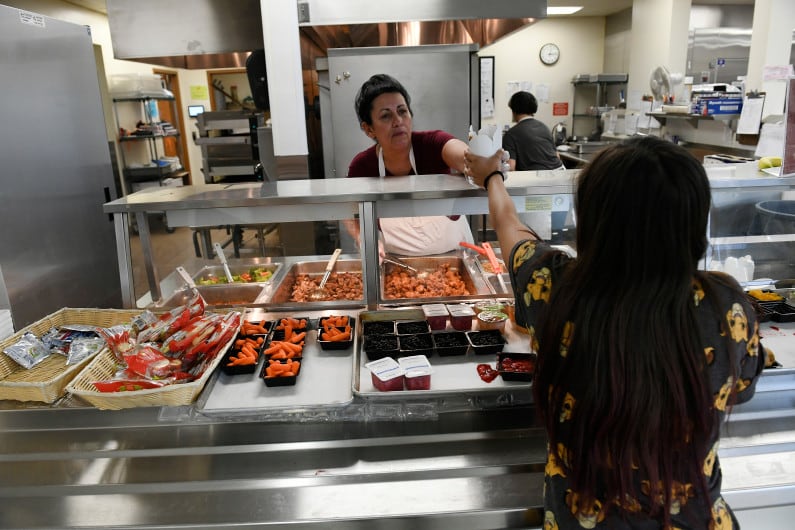School meal programs have faced a host of challenges this year. Staples like chicken, pizza, and muffins are hard to come by. Food deliveries often arrive late, or not at all. There’s still a shortage of cooks and drivers. Inflation is pushing costs up.
Now, schools may be faced with another test: the end of federal waivers that have kept meal costs down and made it easier to serve students food during the pandemic. Their omission from the latest federal budget deal has schools bracing for costs to increase next year and scrambling to plan their summer meal programs.
“School nutrition directors are really worried about what happens next, summer food sponsors are really worried about how they’re going to operate their programs,” said Crystal FitzSimons, the director of school programs for the nonprofit Food Research & Action Center. “We think it’s going to be a crisis.”
Early in the pandemic, federal officials issued several waivers that allowed schools to serve meals in ways they typically wouldn’t be able to under federal rules. Those allowances, extended through this school year, permitted schools to continue to do things like hand out grab-and-go meals when students had to quarantine or temporarily return to virtual learning, and serve meals in classrooms to allow for more social distancing.
Those provisions may be less necessary now, as cases fall and schools return to more normal operations. But the waivers also meant schools got back more money per meal than they typically would during the school year. That helped offset rising food costs and higher pay for cafeteria workers and delivery drivers that many schools offered to remain competitive in a tight labor market — pressures many schools are still facing.
When the waivers expire, schools will take in $1.65 less per meal on average, a 36% drop, according to a federal estimate.
Almost 90% of school meal programs that responded to a fall survey said they relied on the waiver that raises reimbursement rates this school year, according to an agriculture department report released earlier this month. Programs using the waiver were less likely to be running their school meal program at a financial loss.
The waivers also permitted any student to eat meals at no cost to them, lifting paperwork requirements for schools and helping families whose income shifted suddenly during the pandemic.
Advocates like FitzSimons say those provisions have “had a tremendous impact on both making sure that kids are in the classroom, nourished, and ready to learn.”
The waivers are set to expire at the end of June, and the Biden administration and Congressional Democrats had pushed to extend those provisions in the latest federal budget deal. But the waiver extensions weren’t in the package the House passed on Wednesday. The Senate is expected to approve that legislation as early as this weekend.
Leading Republican lawmakers have objected to continuing the school meal waivers in part because of the added costs, the Washington Post has reported. That higher reimbursement rate will likely cost the federal government some $8 billion this school year, a January agriculture department estimate found. The lawmakers saw the waivers as a temporary fix that was no longer needed.
Many schools expect to face higher school meal program costs, food supply issues, and labor shortages through the summer and into next school year, though, the recent federal report found.
When the waivers expire, schools will also again face financial penalties if they can’t meet the usual national nutrition standards, which can happen when schools have to substitute food items if an order gets canceled or arrives without certain ingredients. Nearly nine in 10 school food programs that responded to the federal survey this fall reported that they’d made such substitutions.
“Schools want to be investing more in students for addressing learning loss, and all sorts of other needs,” said Carolyn Vega, the associate policy director at Share Our Strength, a nonprofit that works to address child hunger. “So it would be really terrible for them to also have to try to use that money for school meals when there was another way that we could help offset those higher costs.”
Advocates say there could be more fallout from the expiration of the waivers, too. If another COVID wave or variant arises later this year, schools wouldn’t have the option to offer grab-and-go meals or make meal deliveries to students at home if they have to quarantine or learn virtually.
And advocates worry the end of the waivers will make it harder to serve food to children over the summer, which is usually a difficult time to reach families.
While summer meal programs typically have to be set up in areas where many students from low-income families live, the pandemic-era waivers permitted summer meal programs to run in more places, such as shopping plazas or community centers that are more centrally located but have lower poverty levels in the surrounding area.
Uncertainty about the extension of the waivers, FitzSimons said, has complicated efforts to hire summer staff, choose locations, and decide how many meals to serve.
Schools had hoped to gear up for more typical meal operations this summer and fall, Vega said, but they’ve faced a lot of obstacles.
“This school year ended up being a lot more challenging than anyone ever envisioned, between the supply chain issues and ongoing pandemic-related issues with the delta wave and then omicron,” she said. “We did not have the time and space to think through all of those things and begin that transition process.”
Kalyn Belsha is a national reporter based in Chicago. Contact her at kbelsha@chalkbeat.org.






